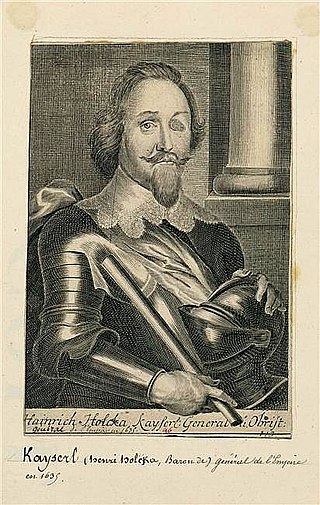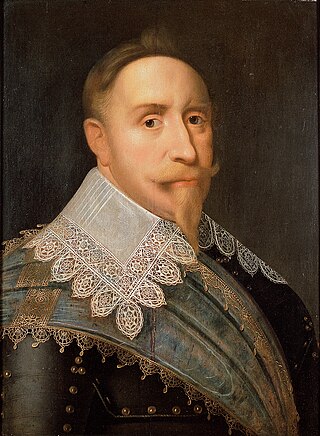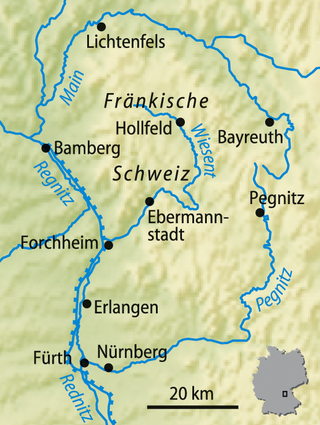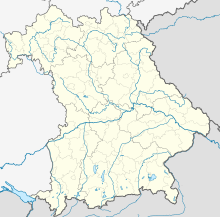
The Battle of Lützen, fought on 6 November 1632, is considered one of the most important battles of the Thirty Years' War. Led by the Swedish king Gustavus Adolphus, an Allied army primarily composed of troops from Sweden, Saxony, and Hesse-Kassel, narrowly defeated an Imperial force under Albrecht von Wallenstein. Both sides suffered heavy casualties, with Gustavus himself among the dead.

The Battle of Nördlingen took place on 6 September 1634 during the Thirty Years' War. A combined Imperial-Spanish force inflicted a crushing defeat on the Swedish-German army.

Johan Banér was a Swedish field marshal in the Thirty Years' War.

is a town in the Burgenlandkreis district of Saxony-Anhalt, Germany.

Albrecht Wenzel Eusebius von Wallenstein, also von Waldstein, was a Bohemian military leader and statesman who fought on the Catholic side during the Thirty Years' War (1618–1648). His successful martial career made him one of the richest and most influential men in the Holy Roman Empire by the time of his death. Wallenstein became the supreme commander of the armies of the Imperial Army of Holy Roman Emperor Ferdinand II and was a major figure of the Thirty Years' War.

Matthias Gallas, Graf von Campo und Herzog von Lucera was an Italian professional soldier during the Thirty Years' War. He distinguished himself in the first half of the war in service of the Catholic League, in the War of the Mantuan Succession, and as one of Albrecht von Wallenstein's Generals. After carrying out the dismissal and elimination of Wallenstein, Gallas became acting supreme commander of the Imperial Army three times between 1634 and 1647 but he never held the function or authority of a Generalissimo.

The Battle of Rain, also called Battle of the River Lech, took place on 15 April 1632 near Rain in Bavaria during the Thirty Years' War. It was fought by a Swedish-German army under Gustavus Adolphus of Sweden, and a Catholic League force led by Johann Tserclaes, Count of Tilly. The battle resulted in a Swedish victory, while Tilly was severely wounded and later died of his injuries.

The Battle of Breitenfeld or First Battle of Breitenfeld, was fought at a crossroads near Breitenfeld approximately 8 km north-west of the walled city of Leipzig on 17 September, or 7 September, 1631. A Swedish-Saxon army led by King Gustavus Adolphus of Sweden and Saxon Elector John George I defeated an Imperial-Catholic League Army led by Generalfeldmarschall Johann Tserclaes, Count of Tilly. It was the Protestants' first major victory of the Thirty Years War.

The Second Battle of Breitenfeld, also known as the First Battle of Leipzig, took place during the Thirty Years' War on 2 November 1642 at Breitenfeld, north-east of Leipzig in Germany. A Swedish Army commanded by Lennart Torstensson decisively defeated an Imperial Army under Archduke Leopold Wilhelm of Austria and his deputy Ottavio Piccolomini.

Ottavio Piccolomini, 1st Duke of Amalfi was an Italian nobleman whose military career included service as a Spanish general and then as a field marshal of the Holy Roman Empire.

The siege of Nuremberg was a campaign that took place in 1632 about the Imperial City of Nuremberg during the Thirty Years' War.

The Battle of Werben took place during the Thirty Years' War on 7 August 1631 (N.S.), between the Swedish Empire and the Holy Roman Empire. The Swedes had 15,100 soldiers and were led by Gustavus Adolphus, while the Imperialists had 16,200 soldiers and were led by Field-Marshal Count Tilly. Tilly's troops attacked Gustavus' entrenchments in front of Werben (Elbe), but Swedish batteries and the cavalry under Wolf Heinrich von Baudissin forced them to retreat, at the cost of 6,000 Imperials and 200 Swedes.

The Battle of Herbsthausen, also known as the Battle of Mergentheim, took place near Bad Mergentheim, in the modern German state of Baden-Württemberg. Fought on 5 May 1645, during the Thirty Years War, it featured a French army led by Turenne, defeated by a Bavarian force under Franz von Mercy.

Heinrich Holk was a Danish-German mercenary in both Christian IV of Denmark's and Albrecht von Wallenstein's service during the Thirty Years' War.

Gustavus Adolphus, also known in English as Gustav II Adolf or Gustav II Adolph, was King of Sweden from 1611 to 1632, and is credited with the rise of Sweden as a great European power. During his reign, Sweden became one of the primary military forces in Europe during the Thirty Years' War, helping to determine the political and religious balance of power in Europe. He was formally and posthumously given the name Gustavus Adolphus the Great by the Riksdag of the Estates in 1634.

The Battle of Fürth was fought on 3 September 1632 between the Catholic forces of Holy Roman Emperor Ferdinand II and the Protestant forces of King Gustavus II of Sweden during the period of Swedish intervention in the Thirty Years War.

Events from the year 1632 in Sweden.

Johann Philipp Kratz von Scharffenstein was a German nobleman and field marshal, who fought during the course of the Thirty Years' War. He served with distinction in forces of both the Catholic League and Holy Roman Empire. His poor relationship with the Imperial generalissimo Albrecht von Wallenstein frustrated his plan of becoming the supreme commander of the League's forces. Embittered by this he defected to Sweden, where he attained the rank of field marshal. He was captured at the Battle of Nördlingen in 1634 and executed for treason a year later.

The Battle of Bamberg took place on 9 March 1632 during the Thirty Years' War. The army of the Catholic League led by Count Tilly surprised and routed the Swedes led by Gustav Horn and captured the city.

Jan van der Croon, also called Jan della Croon, Johann de la Corona, or von der Cron, was a Dutch professional soldier and military commander in Spanish and Imperial service who reached the rank of lieutenant field marshal. Rising from a common soldier to an important officer, regiment holder, and city commander during the Thirty Years' War, he continued his career after the Peace of Westphalia in the military administration of Bohemia. For many years until his death, he served as city commander of Prague and vice military commander of Bohemia, strengthening fortifications and recruiting soldiers for the Second Northern War and the Austro-Turkish War.























